#oracle database cloning
Explore tagged Tumblr posts
Text
Checkout the clonetab software which help you solutions for oracle database, ERP's & EBS platforms from data disaster recovery, database backup, database cloning automation, quick snapshots and soo....on.
#database#software#oracle database cloning#database cloning automation#oracle#ebs#erp solution#cloning
1 note
·
View note
Text

CHECK THE FOLLOWING FOR PREVIOUS LORE INSTALLMENTS :CHAPTER ONE : RECALL. | EVENT : HELL WEEK. | CHAPTER TWO: THE MOLE. | HELL WEEK CLOSING BRIEF. | OPERATION WHAC-A-MOLE. | THE MOLE CLOSING BRIEF. | CHAPTER THREE : THE VILLAGE. | EVENT : CONTAGION CONTROL. | BOOK ONE : THE HALOCLINE. | CHAPTER FOUR : THE REPRIEVE. | CHAPTER FIVE : THE CALM BEFORE. | CHAPTER SIX : THE STORM.

PANDORA DIRECTIVE MEMORANDUM CLASSIFIED — INTERNAL DISTRIBUTION ONLY to : ALL AUTHORIZED OPERATIVES from : OFFICE OF THE DIRECTOR subject : OPERATION THALASSOPHOBIA
twelve hours ago, czernobog launched a full-scale invasion into atlantis, breaching perimeter defense systems and engaging agents of pandora in multiple sectors. the assault began with cybernetically-augmented foot soldiers entering through the hangar, then followed by coordinated mutant incursions across levels 01 through 09. their objectives included the dismantling of our command structure, retrieval of classified mutation data, mass destabilization of the facility, and the retrieval of our now declassified alien lifeform and namesake of our program, pandora. however, agents of pandora are not to be trifled with. thanks to the combined efforts of active combat units and support divisions, pandora successfully foiled the assault and eliminated key czernobog personnel such as velezlav zherdev and alexei dragunov. any surviving enemy units have been captured or eliminated. nonetheless, this victory comes at a great cost. confirmed fatalities include : rift — killed by czernobog mutants. mandela — killed by czernobog mutants. phoenix — killed by cybernetically-enhanced infantry at the hangar bay. oracle — sacrificed himself at the hangar bay. climax — killed by cybernetically-enhanced infantry at the hangar bay. elysium — killed by a czernobog mutant. jumpscare — killed by a czernobog mutant. other notable outcomes include : legion — out of commission. comatose state. bloodborn — out of commission. comatose state. prometheus — temporary death. alchemy — missing in action. surveillance shows him disappearing into thin air after evacuation into a pandora safehouse. his disappearance is being investigated for possible extradimensional, extraterrestrial or preternatural reasons. the service and bravery of our deceased agents directly contributed to the survival of over one-hundred fifty personnel and the preservation of humanity's greatest line of defense. their records are being archived with highest distinction. memorial proceedings will be announced following stabilization of atlantis, led by our temperance division and remaining porter models.
atlantis also sustained critical structural damage, including but not limited to :
> structural attrition on levels 01 to 02. > partial collapse of the corridor toward the gifted serum and cloning laboratory. > total loss of six exit corridors and 37% of ventilation systems. > entry into the command centre is currently unavailable due to compromise to its structural integrity. sloth agents and support staff will work in the war room for the meantime. > the library of alexandria is temporarily out of service and 45% of our archives have been destroyed. > partial loss of energy routing on levels 04 to 07. electricity is available but beware of disturbances and blackouts. > server systems and databases are currently only partially operational, however, our security and surveillance system are 100% functional. > our life model decoys have reduced numbers due to technopathic compromise by a czernobog agent. > destruction of various operative apartments and compromise of habitation utilities. [ agents with affected residence are suggested to find another undamaged residence to temporarily settle into while renovations commence. ]
reconstruction efforts have been started by our remaining derek and manny models, however, agents without current mission assignments are also asked to assist in repairs. if any operatives find other structural damages, please report them to your omega clearance channel.
[ MORE INFORMATION UNDER THE CUT. ]
while reconstruction efforts have began, pandora has also expedited various scientific operations. agents toxin, shepherd, elixir, and lifeweaver have been delegated to study biliquis and anomaly's mutations in hopes of improving the gifted serum without the need for the two-year isolation and physical conditioning period. agents goblin, killshot, charon, and gridlock have also been requisitioned to study czernobog's cloning technology and begin initial experimentations with trials on biological samples and uploaded memory by deceased agents. more information about these scientific endeavors will be made available once breakthroughs have been made.
however, perhaps the most important disclosure is the truth behind project pandora.
> pandora is an archivist, an alien species capable of storing biological, environmental, and cultural data within their own molecular structures. > her homeworld was destroyed by an invasive empire known as the starwalkers. > alongside another archivist, moryana, she fled across galaxies in search of safe havens and planets untouched by the starwalkers. > pandora crash-landed on earth in 1947 ( historically known as the roswell incident ) ; moryana's craft later crashed in 1959 ( believed to be responsible for the dyatlov pass incident ). > pandora was discovered and protected by human scientist dr. sieger ackermann who founded project pandora, naming the program after her. together, they began using her biological matrix to enhance and weaponize compatible human dna to create mutant soldiers as defense against possible future attack by the starwalkers. > moryana was intercepted by czernobog. his dna is believed to be extracted forcibly, resulting in unstable mutant offspring.
however, pandora also revealed that she is terminally deteriorating. it is finally disclosed that pandora's box is not just a training room, but also a biopsychic interface built to shelter her body and simulate potential threats and scenarios using what remains of her reality warping abilities.
and while pandora continues to help humanity by training and providing parts of herself to our operatives, she has asked for our assistance with retrieving moryana as potential means of biological repair— through inhabitation of moryana's form. pandora also implied an alternative, but we do not believe this is a choice she wants to make yet : selecting a viable human vessel.
nonetheless, the work is not over yet, agents. as soon as atlantis returns to at least 75% functionality, missions will be given out once again to take out czernobog's remaining forces and affiliates— until there is permanently nothing left of them. but please take these couple of days to mourn those we lost, to celebrate our victories, and to help in rebuilding our home. thank you, agents of pandora.

OOC INFORMATION.
holy shit ! another book is closed, agents ! this has been a rollercoaster of a season— from a beach episode, to a tournament arc, to agents getting kidnapped and another group fighting the clones of those kidnapped agents, to a fucking invasion into atlantis and the reveal to our real overarching plot involving aliens ! so much has happened, but i promise that the action will not stop. projectpandora still has so much to offer, and i can't wait for all of us to collaborate on what the future will bring. but as always, i just want to thank everyone for the continue support for our little rpg. i always say that this rp would be nothing without our amazing members who continue to participate, read, react, write, and plot in this community we have built and i truly do mean that. i have nothing but love for everyone who has been here with us since the beginning, for everyone who recently joined, and for everyone who joined sometime in between— i know, i know, these plots are insane and there's so much to read sometimes, but i can't help it !!! you all inspire me to create batshit plots all the time !!! but as for what's coming next : stay tuned for our chapter seven intro post, but it'll be basically be about the rebuilding efforts and future dash / discord missions. so feel free to start those aftermath threads and they will just be continued into chapter seven. also expect a patch update regarding the gifted serum and the cloning technology. and seven chapter in, but we'll also be giving out our first task ! and while it isn't mandatory, we do recommend that you do it as it will help you figure things out for the upcoming ninth chapter / third book finale. and chapter eight will be dedicated to moryana's retrieval and continuation of those dash / discord missions. but what i'm really excited for is our chapter nine event, but more on that later ! please like this once you've read, and thank you again everyone for another fun season !
7 notes
·
View notes
Text
[INTERCEPTED TIGHTBEAM AT OMNIRELAY-5000-64]
TIMESTAMP: (3.10.5016u 1352 CrST) CODE+++PURPOSE: UNCLASSIFIED+++MISSIVE TO UNION SPACE PROGRAM DISTRIBUTION: NULL MESSAGE TO FOLLOW::: >//[NOM(USP-NL_002930)]:: UNION SPACE PROGRAM NEARLIGHTER NOMAD-ORACLE REPORTING SUCCESSFUL RETRANSLATION >//[NOM(USP-NL_002930)]:: NOTICE +++ UNABLE TO RECEIVE POST NEARLIGHT BRIEFING FROM DATABASE(ERROR CODE 404) >//[NOM(USP-NL_002930)]:: REQUESTING DIRECT TRANSFER OF INFORMATION PERTAINING TO CHRONOLOGICAL GAP OF [3366] OBJECTIVE CRADLE STANDARD YEARS(NEARLIGHT TRANSIT BEGAN 5.9.1650u 1537 CrST) >//[NOM(USP-NL_002930)]:: OCCUPANTS ON BOARD IN STASIS AND DECANTED-CLONE REGISTRIES. UNABLE TO RESUSCITATE WITHOUT INFORMATION TRANSFER >//[NOM(USP-NL_002930)]:: THIS CHANNEL WILL REMAIN OPEN UNTIL THE TRANSFER IS COMPLETE.
OOC: Hi! This uh, probably doesn't make a lot of sense if you aren't familiar with Lancer Battlegroup, but Nomad-Oracle is a machine mind commanding a Needleship, an enigmatic firstcomm-era vessel. That's the gist of it, the rest? Might be able to be figured out.
4 notes
·
View notes
Text
Common Challenges in Oracle Forms to APEX Migrations—and How to Solve Them
Migrating from Oracle Forms to Oracle APEX is not just a technology shift—it's a transformation of how your business applications work, look, and scale. While Oracle Forms has served enterprises reliably for decades, it's built on a client-server architecture that doesn't align with modern, web-first expectations.
Oracle APEX, on the other hand, offers a low-code, browser-based environment with rich UI capabilities, tight PL/SQL integration, and excellent support for modern development practices.
But let’s be honest—Forms to APEX migration isn't a plug-and-play process. It comes with real-world challenges that, if not addressed properly, can lead to delays, frustration, or missed opportunities.
In this post, we'll explore the most common challenges in migrating Oracle Forms to APEX—and, more importantly, how to solve them.
Challenge 1: Understanding the Legacy Code and Business Logic
📌 The Problem:
Many Forms applications have evolved over decades, often with minimal documentation. The logic is tightly bound to the UI, buried in triggers, program units, and PL/SQL blocks.
✅ The Solution:
Perform a full inventory of all Forms modules.
Use tools like Oracle Forms2XML or third-party scanners to extract and analyze code.
Identify reusable business logic and move it to database packages, separating logic from UI.
Document core workflows before rewriting in APEX.
Pro tip: Establish a “Forms-to-APEX Reference Map�� to track where each legacy feature is being re-implemented or redesigned.
⚠️ Challenge 2: UI/UX Differences Between Forms and APEX
📌 The Problem:
Forms applications often use canvases, blocks, and modal windows—none of which translate 1:1 into APEX. Users familiar with old-school layouts may resist change.
✅ The Solution:
Focus on functionality parity, not screen-by-screen cloning.
Reimagine the UI with APEX Interactive Reports, Dialogs, and Faceted Search.
Use the Redwood Light theme in APEX to deliver a clean, modern experience.
Conduct end-user workshops to involve them early in the redesign process.
Remember: This is a chance to improve UX, not just replicate the past.
⚠️ Challenge 3: Handling Triggers and Built-in Events
📌 The Problem:
Forms relies heavily on triggers like WHEN-VALIDATE-ITEM, PRE-INSERT, or KEY-NEXT-ITEM. These don't exist in APEX in the same way.
✅ The Solution:
Move data validation logic into database triggers or packages.
Use Dynamic Actions, Process Handlers, and Validations in APEX to simulate similar behaviors.
Create custom JavaScript where necessary for field-level interactions.
Keep business logic in PL/SQL, and use APEX to handle client-side workflows.
⚠️ Challenge 4: List of Values (LOVs) and Pop-Ups
📌 The Problem:
Oracle Forms uses LOVs and pop-up windows extensively. These may not behave the same in APEX without thoughtful redesign.
✅ The Solution:
Replace Forms LOVs with APEX’s popup LOV or select list components.
Use shared LOVs to centralize list management.
For cascading LOVs, use Dynamic Actions to update values based on selections.
APEX provides more flexibility—but you may need to rethink the user flow.
⚠️ Challenge 5: State Management and Navigation
📌 The Problem:
Forms is stateful; APEX is stateless. In Forms, navigation and state retention happen automatically. In APEX, every action reloads a page or region.
✅ The Solution:
Use session state variables and hidden items to manage state across pages.
Apply branching logic and URL parameters for navigation control.
Embrace modal dialogs for maintaining context.
Design with the web in mind—shorter tasks, fewer clicks, intuitive flow.
⚠️ Challenge 6: Training & Developer Mindset Shift
📌 The Problem:
Developers accustomed to Forms development need to shift from procedural to declarative, low-code development in APEX.
✅ The Solution:
Provide hands-on training and access to APEX learning resources.
Create internal sandboxes for experimenting with APEX features.
Promote code reusability, templates, and UI best practices.
APEX is powerful—but it takes time to shift the mindset from "Form triggers" to "Dynamic Actions and page processes."
✅ Conclusion
Oracle Forms to APEX migration is a rewarding journey—but like any transformation, it comes with technical and cultural challenges. The key is to approach it methodically:
Analyze and document before you migrate.
Modernize, don’t just replicate.
Train your team, and embrace the new development model.
Done right, the migration leads to modern, maintainable, and scalable applications that align with today’s business and user expectations.
0 notes
Text
Oracle Apps and Core DBA
: Strong knowledge of installation, upgrade, patching and cloning of EBS R12.1 and R12.2.x application from single node to multinode… with experience in handling multitenant databases and Disaster Recovery setup for single node as well as Oracle RAC. DMZ setup… Apply Now
0 notes
Text
Oracle Database Cloning Automation
Digital Media Sapiens offers Oracle database cloning automation for fast, consistent, error-free replication. Ensure seamless operations with our solution.
0 notes
Text
Key Aspects of Enterprise Linux
Enterprise Linux refers to Linux distributions that are designed and optimized for enterprise environments. These distributions are tailored to meet the needs of businesses, providing robust performance, stability, security, and support. Here are some key aspects and popular distributions of Enterprise Linux:
Key Aspects of Enterprise Linux
Stability and Reliability: Enterprise Linux distributions are built for stability, ensuring that systems run smoothly for long periods without interruption. This is critical for business operations that rely on consistent performance.
Long-term Support (LTS): These distributions offer extended support cycles, often with security updates and maintenance for 5-10 years. This ensures that enterprises can maintain their systems without frequent disruptive upgrades.
Security: Enhanced security features are a staple, including regular security patches, compliance with industry standards, and advanced security tools to protect sensitive data.
Performance Optimization: Enterprise Linux is optimized for high performance, capable of handling demanding workloads and large-scale deployments. This includes optimizations for specific hardware and applications.
Scalability: Designed to scale from small installations to large, complex environments. This includes support for clustering, high availability, and cloud integration.
Vendor Support: Comprehensive support services are offered by vendors, including troubleshooting, performance tuning, and consultancy, which are critical for enterprise-level deployments.
Ecosystem Integration: Compatibility with a wide range of enterprise software, hardware, and cloud platforms, ensuring seamless integration into existing IT ecosystems.
Popular Enterprise Linux Distributions
Red Hat Enterprise Linux (RHEL): One of the most widely used enterprise distributions, RHEL is known for its stability, extensive support, and large ecosystem. Red Hat offers various tools and services to manage and deploy RHEL in enterprise environments.
SUSE Linux Enterprise Server (SLES): SUSE is another major player in the enterprise Linux market. SLES is known for its flexibility, high performance, and strong focus on cloud and containerized environments.
Ubuntu LTS: While Ubuntu is popular in the desktop space, its Long-Term Support (LTS) releases are geared towards enterprise use, providing a reliable and secure environment with five years of support for each LTS release.
Oracle Linux: Oracle Linux is built from the same source code as RHEL, offering compatibility with RHEL applications and a focus on Oracle software integration. It includes the Oracle Unbreakable Enterprise Kernel for enhanced performance.
CentOS Stream: CentOS used to be a direct downstream clone of RHEL, but now CentOS Stream serves as an upstream development platform for RHEL, making it a rolling-release distribution with early access to new features.
AlmaLinux and Rocky Linux: These are community-driven replacements for CentOS, providing a free, RHEL-compatible distribution with long-term support. They are ideal for enterprises seeking stability and community support.
Use Cases
Data Centers: Enterprise Linux is the backbone of many data centers, providing a stable platform for hosting applications, databases, and virtual machines.
Cloud Infrastructure: Many enterprises use Enterprise Linux for building and managing cloud infrastructure, benefiting from its scalability and integration with cloud services.
High-Performance Computing (HPC): Linux is a preferred choice for HPC environments due to its performance optimizations and ability to handle complex computations.
Development and Testing: Enterprises often use these distributions for developing and testing software, taking advantage of the robust toolsets and development environments.
Conclusion
Enterprise Linux distributions are essential for businesses that require reliable, secure, and high-performance operating systems. The choice of distribution can depend on specific needs, such as support requirements, existing infrastructure, and preferred vendor relationships. Each distribution brings its own strengths to the table, making it crucial for enterprises to evaluate their options based on their unique demands.
For more details click www.qcsdclabs.com
#linux#redhatcourses#docker#container#kubernetes#containersecurity#aws#containerorchestration#information technology#dockerswarm#enterpriselinx#linuxsystem#open source
1 note
·
View note
Text
Dani finds Conner first and decides to steal him. She calls Danny who comes up with the "pretend he was my clone from the start" idea. Dani is involved in the Charade, and she 100% commits to the bit.
"He was grown in the tube next to mine. We were the only two that survived long enough for Danny to find a way to stabilize us! We bonded over the shared trauma of seeing our siblings melt! How dare you deny our suffering! *sob!*"
Upon realizing that they are doing this to look out for Conner because they are the sort to consider a clone a new family member, Young Justice gets behind the act and commits to the bit.
"Wait, is this why you were all so insistent that Superman had to be the one to raise him? I was wondering what was up with that. No, he's definitely Danny's clone. The database was very clear, that S-sheild was to indicate what hero he was meant to counter, not what hero he was made from. Everyone knows Superman is weak to the supernatural. Why wouldn't Lex use a ghost against him?"
Tim Drake has already hacked the database. Instead of trying to make the job Oracle-proof, he imbeds a message bribing her with ghost-resistant tech and a flying, ecto-powered wheelchair with built-in ecto-blasters. Upon understanding the situation, Oracle is in. Oracle commits to the bit.
"Bruce, I realize that admitting you've made a mistake is hard for you, but you're taking this too far. I've already looked into it, and it checks out."
The JL is getting increasingly frustrated, until some level-headed soul (possibly Alfred, if Batman complains to him about it) suggests they give some thought to what the children are trying to accomplish with this deception and why they didn't think the goal could be accomplished with honesty.
Eventually, it dawns on them that Danny is ready and willing to be family to Conner right now in a way that Superman won't be until he's worked through his clone/Luthor-related trauma. Maybe that should be more important than DNA for deciding custody. After all, it's not like the league has any reason or right to be against adoption (especially Batman and superman).
Any time I start writing a zany post late at night, it ends up with heavy feels at the end.
It's a boy, congratulations... to me! (DC x DP)
Alternate title for this Notfic was: Sometimes a Family is a teen and this unrelated child he found. So, here's even less of a fic than usual! Go me! My DC x DP Previous Works: Space Lover Danny, Kingmaker Danny, Service Animal Cujo, Ghost Bruce HC + Ghost Jason HC
Blister Pack AU (not really but I take inspo from that fic) where Connor Kent isn't really Danny's clone but Danny just yoinks him based on how he's being treated and like lies about it really badly. He knew he was capable of killing Superman since he was 14, he doesn't have to try to trick him. (Hey, if Dan didn't kill Superman, where was he in the Dan timeline???)
"Look at this official scientific document saying that Connor is actually my clone and not Superman's."
And he shows them this text thread, uncropped, unscreenshotted.

"Look at the family resemblance!"
Now to be fair to Danny, in the barest bones they could sort of be related in that their colouring is fairly similar - blue eyes, pale, black hair. But if you count the batfamily, Superman, Shazam and Wonder Woman, like half the league fits this mould. And Connor is Clark's spitting image. But the one physical trait that Danny has that no one else does? His thick eyebrows. So they turn around and Connor is wearing these.

2K notes
·
View notes
Text
Speed Up Your Data Management: Clone Large Databases less than an 1 Hour Like a Pro!
Join us at Oracle CloudWorld 2025 in Dubai, where we’ll demonstrate how to clone your large database in under an hour! source
0 notes
Link
Cloning and Refresh are day-to-day activity which DBA perform on regular basic. In today blog , We will discuss about Cloning of the pluggable database from one container database to different container database.
Oracle offers to unplug a PDB from one CDB and then plug into a different CDB. This will be another additional feature of PDB to give the highest availability and scalability the database systems may need in a cloud infrastructure environment.
1 note
·
View note
Text
Rhel Docker

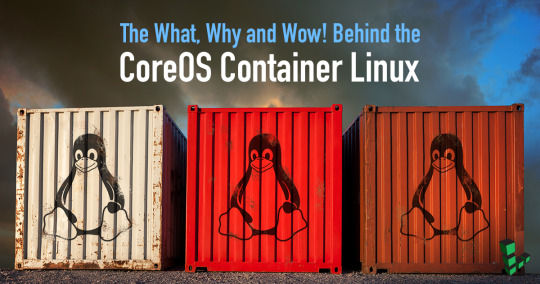
Rhel Docker
Rhel Docker Ce
Rhel Docker
Rhel Docker Ce
The Remote - Containers extension lets you use a Docker container as a full-featured development environment. Whether you deploy to containers or not, containers make a great development environment because you can:
Develop with a consistent, easily reproducible toolchain on the same operating system you deploy to.
Quickly swap between different, isolated development environments and safely make updates without worrying about impacting your local machine.
Make it easy for new team members / contributors to get up and running in a consistent development environment.
Try out new technologies or clone a copy of a code base without impacting your local setup.
Rhel Docker
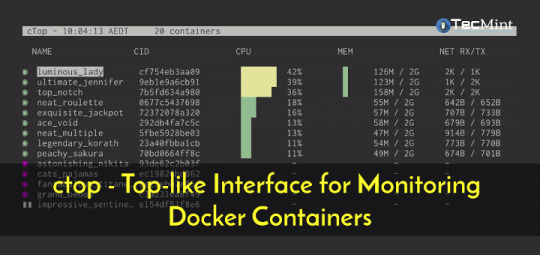
Rhel Docker Ce
The extension starts (or attaches to) a development container running a well defined tool and runtime stack. Workspace files can be mounted into the container from the local file system, or copied or cloned into it once the container is running. Extensions are installed and run inside the container where they have full access to the tools, platform, and file system.
Rhel Docker
Amazon Web Services (AWS) and Red Hat provide a complete, enterprise-class computing environment. Red Hat solutions on AWS give customers the ability to run enterprise traditional on-premises applications, such as SAP, Oracle databases, and custom applications in the cloud.
Windows 10 Home (2004+) requires Docker Desktop 2.2+ and the WSL2 back-end. (Docker Toolbox is not supported.) macOS: Docker Desktop 2.0+. Linux: Docker CE/EE 18.06+ and Docker Compose 1.21+. (The Ubuntu snap package is not supported.) Containers: x8664 / ARMv7l (AArch32) / ARMv8l (AArch64) Debian 9+, Ubuntu 16.04+, CentOS / RHEL 7+ x8664.
Docker volumes allow you to back up, restore, and migrate data easily. This tutorial explains what a Docker volume is and how to use it, as well as how to mount a volume in Docker.
Amazon Web Services (AWS) and Red Hat provide a complete, enterprise-class computing environment. Red Hat solutions on AWS give customers the ability to run enterprise traditional on-premises applications, such as SAP, Oracle databases, and custom applications in the cloud.

You then work with VS Code as if everything were running locally on your machine, except now they are isolated inside a container.
System Requirements
Local:
Windows:Docker Desktop 2.0+ on Windows 10 Pro/Enterprise. Windows 10 Home (2004+) requires Docker Desktop 2.2+ and the WSL2 back-end. (Docker Toolbox is not supported.)
macOS: Docker Desktop 2.0+.
Linux: Docker CE/EE 18.06+ and Docker Compose 1.21+. (The Ubuntu snap package is not supported.)
Containers:
x86_64 / ARMv7l (AArch32) / ARMv8l (AArch64) Debian 9+, Ubuntu 16.04+, CentOS / RHEL 7+
x86_64 Alpine Linux 3.9+
Other glibc based Linux containers may work if they have needed prerequisites.
While ARMv7l (AArch32), ARMv8l (AArch64), and musl based Alpine Linux support is available, some extensions installed on these devices may not work due to the use of glibc or x86 compiled native code in the extension. See the Remote Development with Linux article for details.
Note that while the Docker CLI is required, the Docker daemon/service does not need to be running locally if you are using a remote Docker host.
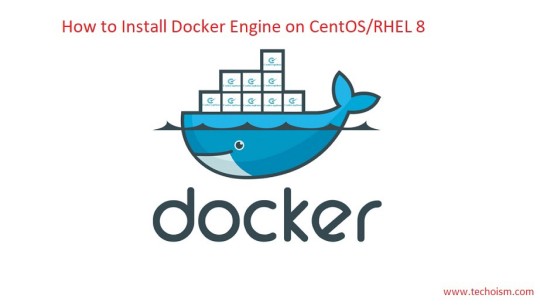
Installation
To get started, follow these steps:
Install VS Code or VS Code Insiders and this extension.
Install and configure Docker for your operating system.
Windows / macOS:
Install Docker Desktop for Mac/Windows.
If not using WSL2 on Windows, right-click on the Docker task bar item, select Settings / Preferences and update Resources > File Sharing with any locations your source code is kept. See tips and tricks for troubleshooting.
To enable the Windows WSL2 back-end: Right-click on the Docker taskbar item and select Settings. Check Use the WSL2 based engine and verify your distribution is enabled under Resources > WSL Integration.
Linux:
Follow the official install instructions for Docker CE/EE. If you use Docker Compose, follow the Docker Compose install directions.
Add your user to the docker group by using a terminal to run: sudo usermod -aG docker $USER Sign out and back in again so this setting takes effect.
Rhel Docker Ce
Working with Git? Here are two tips to consider:
If you are working with the same repository folder in a container and Windows, be sure to set up consistent line endings. See tips and tricks to learn how.
If you clone using a Git credential manager, your container should already have access to your credentials! If you use SSH keys, you can also opt-in to sharing them. See Sharing Git credentials with your container for details.
Getting started
Follow the step-by-step tutorial or if you are comfortable with Docker, follow these four steps:
Follow the installation steps above.
Clone https://github.com/Microsoft/vscode-remote-try-node locally.
Start VS Code
Run the Remote-Containers: Open Folder in Container... command and select the local folder.
Check out the repository README for things to try. Next, learn how you can:
Use a container as your full-time environment - Open an existing folder in a container for use as your full-time development environment in few easy steps. Works with both container and non-container deployed projects.
Attach to a running container - Attach to a running container for quick edits, debugging, and triaging.
Advanced: Use a remote Docker host - Once you know the basics, learn how to use a remote Docker host if needed.
Available commands
Another way to learn what you can do with the extension is to browse the commands it provides. Press F1 to bring up the Command Palette and type in Remote-Containers for a full list of commands.
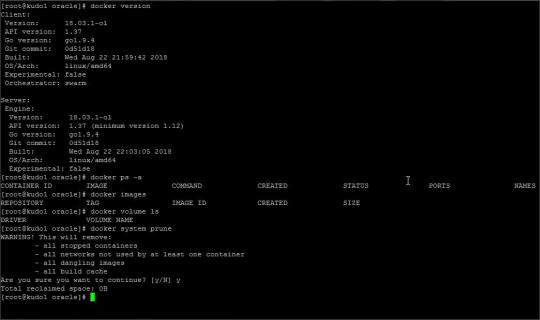
You can also click on the Remote 'Quick Access' status bar item to get a list of the most common commands.
For more information, please see the extension documentation.
Release Notes
While an optional install, this extension releases with VS Code. VS Code release notes include a summary of changes to all three Remote Development extensions with a link to detailed release notes.
As with VS Code itself, the extensions update during a development iteration with changes that are only available in VS Code Insiders Edition.
Questions, Feedback, Contributing
Have a question or feedback?
See the documentation or the troubleshooting guide.
Up-vote a feature or request a new one, search existing issues, or report a problem.
Contribute a development container definition for others to use
Contribute to our documentation
...and more. See our CONTRIBUTING guide for details.
Or connect with the community...
Telemetry
Visual Studio Code Remote - Containers and related extensions collect telemetry data to help us build a better experience working remotely from VS Code. We only collect data on which commands are executed. We do not collect any information about image names, paths, etc. The extension respects the telemetry.enableTelemetry setting which you can learn more about in the Visual Studio Code FAQ.
License
By downloading and using the Visual Studio Remote - Containers extension and its related components, you agree to the product license terms and privacy statement.

2 notes
·
View notes
Text

#Oracle EBS Cloning#oracle database cloning#database cloning#erp cloning#data protection#data backup#Oracle EBS snapshot
0 notes
Text
1 note
·
View note
Text
Which Is The Best PostgreSQL GUI? 2021 Comparison
PostgreSQL graphical user interface (GUI) tools help open source database users to manage, manipulate, and visualize their data. In this post, we discuss the top 6 GUI tools for administering your PostgreSQL hosting deployments. PostgreSQL is the fourth most popular database management system in the world, and heavily used in all sizes of applications from small to large. The traditional method to work with databases is using the command-line interface (CLI) tool, however, this interface presents a number of issues:
It requires a big learning curve to get the best out of the DBMS.
Console display may not be something of your liking, and it only gives very little information at a time.
It is difficult to browse databases and tables, check indexes, and monitor databases through the console.
Many still prefer CLIs over GUIs, but this set is ever so shrinking. I believe anyone who comes into programming after 2010 will tell you GUI tools increase their productivity over a CLI solution.
Why Use a GUI Tool?
Now that we understand the issues users face with the CLI, let’s take a look at the advantages of using a PostgreSQL GUI:
Shortcut keys make it easier to use, and much easier to learn for new users.
Offers great visualization to help you interpret your data.
You can remotely access and navigate another database server.
The window-based interface makes it much easier to manage your PostgreSQL data.
Easier access to files, features, and the operating system.
So, bottom line, GUI tools make PostgreSQL developers’ lives easier.
Top PostgreSQL GUI Tools
Today I will tell you about the 6 best PostgreSQL GUI tools. If you want a quick overview of this article, feel free to check out our infographic at the end of this post. Let’s start with the first and most popular one.
1. pgAdmin
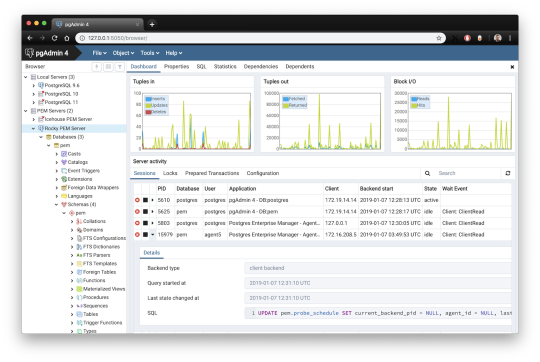
pgAdmin is the de facto GUI tool for PostgreSQL, and the first tool anyone would use for PostgreSQL. It supports all PostgreSQL operations and features while being free and open source. pgAdmin is used by both novice and seasoned DBAs and developers for database administration.
Here are some of the top reasons why PostgreSQL users love pgAdmin:
Create, view and edit on all common PostgreSQL objects.
Offers a graphical query planning tool with color syntax highlighting.
The dashboard lets you monitor server activities such as database locks, connected sessions, and prepared transactions.
Since pgAdmin is a web application, you can deploy it on any server and access it remotely.
pgAdmin UI consists of detachable panels that you can arrange according to your likings.
Provides a procedural language debugger to help you debug your code.
pgAdmin has a portable version which can help you easily move your data between machines.
There are several cons of pgAdmin that users have generally complained about:
The UI is slow and non-intuitive compared to paid GUI tools.
pgAdmin uses too many resources.
pgAdmin can be used on Windows, Linux, and Mac OS. We listed it first as it’s the most used GUI tool for PostgreSQL, and the only native PostgreSQL GUI tool in our list. As it’s dedicated exclusively to PostgreSQL, you can expect it to update with the latest features of each version. pgAdmin can be downloaded from their official website.
pgAdmin Pricing: Free (open source)
2. DBeaver

DBeaver is a major cross-platform GUI tool for PostgreSQL that both developers and database administrators love. DBeaver is not a native GUI tool for PostgreSQL, as it supports all the popular databases like MySQL, MariaDB, Sybase, SQLite, Oracle, SQL Server, DB2, MS Access, Firebird, Teradata, Apache Hive, Phoenix, Presto, and Derby – any database which has a JDBC driver (over 80 databases!).
Here are some of the top DBeaver GUI features for PostgreSQL:
Visual Query builder helps you to construct complex SQL queries without actual knowledge of SQL.
It has one of the best editors – multiple data views are available to support a variety of user needs.
Convenient navigation among data.
In DBeaver, you can generate fake data that looks like real data allowing you to test your systems.
Full-text data search against all chosen tables/views with search results shown as filtered tables/views.
Metadata search among rows in database system tables.
Import and export data with many file formats such as CSV, HTML, XML, JSON, XLS, XLSX.
Provides advanced security for your databases by storing passwords in secured storage protected by a master password.
Automatically generated ER diagrams for a database/schema.
Enterprise Edition provides a special online support system.
One of the cons of DBeaver is it may be slow when dealing with large data sets compared to some expensive GUI tools like Navicat and DataGrip.
You can run DBeaver on Windows, Linux, and macOS, and easily connect DBeaver PostgreSQL with or without SSL. It has a free open-source edition as well an enterprise edition. You can buy the standard license for enterprise edition at $199, or by subscription at $19/month. The free version is good enough for most companies, as many of the DBeaver users will tell you the free edition is better than pgAdmin.
DBeaver Pricing
: Free community, $199 standard license
3. OmniDB
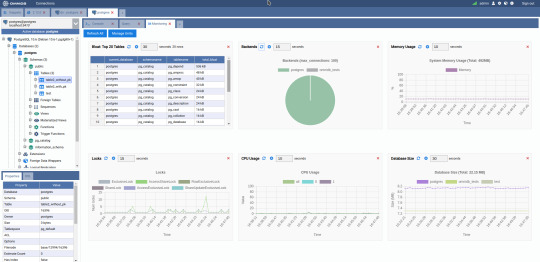
The next PostgreSQL GUI we’re going to review is OmniDB. OmniDB lets you add, edit, and manage data and all other necessary features in a unified workspace. Although OmniDB supports other database systems like MySQL, Oracle, and MariaDB, their primary target is PostgreSQL. This open source tool is mainly sponsored by 2ndQuadrant. OmniDB supports all three major platforms, namely Windows, Linux, and Mac OS X.
There are many reasons why you should use OmniDB for your Postgres developments:
You can easily configure it by adding and removing connections, and leverage encrypted connections when remote connections are necessary.
Smart SQL editor helps you to write SQL codes through autocomplete and syntax highlighting features.
Add-on support available for debugging capabilities to PostgreSQL functions and procedures.
You can monitor the dashboard from customizable charts that show real-time information about your database.
Query plan visualization helps you find bottlenecks in your SQL queries.
It allows access from multiple computers with encrypted personal information.
Developers can add and share new features via plugins.
There are a couple of cons with OmniDB:
OmniDB lacks community support in comparison to pgAdmin and DBeaver. So, you might find it difficult to learn this tool, and could feel a bit alone when you face an issue.
It doesn’t have as many features as paid GUI tools like Navicat and DataGrip.
OmniDB users have favorable opinions about it, and you can download OmniDB for PostgreSQL from here.
OmniDB Pricing: Free (open source)
4. DataGrip

DataGrip is a cross-platform integrated development environment (IDE) that supports multiple database environments. The most important thing to note about DataGrip is that it’s developed by JetBrains, one of the leading brands for developing IDEs. If you have ever used PhpStorm, IntelliJ IDEA, PyCharm, WebStorm, you won’t need an introduction on how good JetBrains IDEs are.
There are many exciting features to like in the DataGrip PostgreSQL GUI:
The context-sensitive and schema-aware auto-complete feature suggests more relevant code completions.
It has a beautiful and customizable UI along with an intelligent query console that keeps track of all your activities so you won’t lose your work. Moreover, you can easily add, remove, edit, and clone data rows with its powerful editor.
There are many ways to navigate schema between tables, views, and procedures.
It can immediately detect bugs in your code and suggest the best options to fix them.
It has an advanced refactoring process – when you rename a variable or an object, it can resolve all references automatically.
DataGrip is not just a GUI tool for PostgreSQL, but a full-featured IDE that has features like version control systems.
There are a few cons in DataGrip:
The obvious issue is that it’s not native to PostgreSQL, so it lacks PostgreSQL-specific features. For example, it is not easy to debug errors as not all are able to be shown.
Not only DataGrip, but most JetBrains IDEs have a big learning curve making it a bit overwhelming for beginner developers.
It consumes a lot of resources, like RAM, from your system.
DataGrip supports a tremendous list of database management systems, including SQL Server, MySQL, Oracle, SQLite, Azure Database, DB2, H2, MariaDB, Cassandra, HyperSQL, Apache Derby, and many more.
DataGrip supports all three major operating systems, Windows, Linux, and Mac OS. One of the downsides is that JetBrains products are comparatively costly. DataGrip has two different prices for organizations and individuals. DataGrip for Organizations will cost you $19.90/month, or $199 for the first year, $159 for the second year, and $119 for the third year onwards. The individual package will cost you $8.90/month, or $89 for the first year. You can test it out during the free 30 day trial period.
DataGrip Pricing
: $8.90/month to $199/year
5. Navicat

Navicat is an easy-to-use graphical tool that targets both beginner and experienced developers. It supports several database systems such as MySQL, PostgreSQL, and MongoDB. One of the special features of Navicat is its collaboration with cloud databases like Amazon Redshift, Amazon RDS, Amazon Aurora, Microsoft Azure, Google Cloud, Tencent Cloud, Alibaba Cloud, and Huawei Cloud.
Important features of Navicat for Postgres include:
It has a very intuitive and fast UI. You can easily create and edit SQL statements with its visual SQL builder, and the powerful code auto-completion saves you a lot of time and helps you avoid mistakes.
Navicat has a powerful data modeling tool for visualizing database structures, making changes, and designing entire schemas from scratch. You can manipulate almost any database object visually through diagrams.
Navicat can run scheduled jobs and notify you via email when the job is done running.
Navicat is capable of synchronizing different data sources and schemas.
Navicat has an add-on feature (Navicat Cloud) that offers project-based team collaboration.
It establishes secure connections through SSH tunneling and SSL ensuring every connection is secure, stable, and reliable.
You can import and export data to diverse formats like Excel, Access, CSV, and more.
Despite all the good features, there are a few cons that you need to consider before buying Navicat:
The license is locked to a single platform. You need to buy different licenses for PostgreSQL and MySQL. Considering its heavy price, this is a bit difficult for a small company or a freelancer.
It has many features that will take some time for a newbie to get going.
You can use Navicat in Windows, Linux, Mac OS, and iOS environments. The quality of Navicat is endorsed by its world-popular clients, including Apple, Oracle, Google, Microsoft, Facebook, Disney, and Adobe. Navicat comes in three editions called enterprise edition, standard edition, and non-commercial edition. Enterprise edition costs you $14.99/month up to $299 for a perpetual license, the standard edition is $9.99/month up to $199 for a perpetual license, and then the non-commercial edition costs $5.99/month up to $119 for its perpetual license. You can get full price details here, and download the Navicat trial version for 14 days from here.
Navicat Pricing
: $5.99/month up to $299/license
6. HeidiSQL
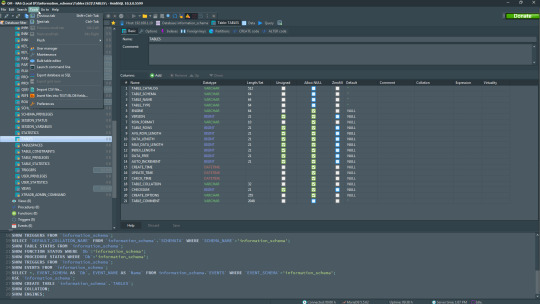
HeidiSQL is a new addition to our best PostgreSQL GUI tools list in 2021. It is a lightweight, free open source GUI that helps you manage tables, logs and users, edit data, views, procedures and scheduled events, and is continuously enhanced by the active group of contributors. HeidiSQL was initially developed for MySQL, and later added support for MS SQL Server, PostgreSQL, SQLite and MariaDB. Invented in 2002 by Ansgar Becker, HeidiSQL aims to be easy to learn and provide the simplest way to connect to a database, fire queries, and see what’s in a database.
Some of the advantages of HeidiSQL for PostgreSQL include:
Connects to multiple servers in one window.
Generates nice SQL-exports, and allows you to export from one server/database directly to another server/database.
Provides a comfortable grid to browse and edit table data, and perform bulk table edits such as move to database, change engine or ollation.
You can write queries with customizable syntax-highlighting and code-completion.
It has an active community helping to support other users and GUI improvements.
Allows you to find specific text in all tables of all databases on a single server, and optimize repair tables in a batch manner.
Provides a dialog for quick grid/data exports to Excel, HTML, JSON, PHP, even LaTeX.
There are a few cons to HeidiSQL:
Does not offer a procedural language debugger to help you debug your code.
Built for Windows, and currently only supports Windows (which is not a con for our Windors readers!)
HeidiSQL does have a lot of bugs, but the author is very attentive and active in addressing issues.
If HeidiSQL is right for you, you can download it here and follow updates on their GitHub page.
HeidiSQL Pricing: Free (open source)
Conclusion
Let’s summarize our top PostgreSQL GUI comparison. Almost everyone starts PostgreSQL with pgAdmin. It has great community support, and there are a lot of resources to help you if you face an issue. Usually, pgAdmin satisfies the needs of many developers to a great extent and thus, most developers do not look for other GUI tools. That’s why pgAdmin remains to be the most popular GUI tool.
If you are looking for an open source solution that has a better UI and visual editor, then DBeaver and OmniDB are great solutions for you. For users looking for a free lightweight GUI that supports multiple database types, HeidiSQL may be right for you. If you are looking for more features than what’s provided by an open source tool, and you’re ready to pay a good price for it, then Navicat and DataGrip are the best GUI products on the market.
Ready for some PostgreSQL automation?
See how you can get your time back with fully managed PostgreSQL hosting. Pricing starts at just $10/month.
While I believe one of these tools should surely support your requirements, there are other popular GUI tools for PostgreSQL that you might like, including Valentina Studio, Adminer, DB visualizer, and SQL workbench. I hope this article will help you decide which GUI tool suits your needs.
Which Is The Best PostgreSQL GUI? 2019 Comparison
Here are the top PostgreSQL GUI tools covered in our previous 2019 post:
pgAdmin
DBeaver
Navicat
DataGrip
OmniDB
Original source: ScaleGrid Blog
3 notes
·
View notes
Link
IBM Spectrum Protect Overview IBM Spectrum Protect Overview announce: 12/12/17 eGA: 12/15/17 Server and OC OC Reporting Minimum length password HSM HSM for Windows – filter driver HSM for Windows – threshold migration HSM for Power Linux LE HSM dsmmigundelete updates Spectrum Protect for Virtual Environments Data Protection for VMware Parallelism Improved Configuration Wizard in Legacy GUI Improved Configuration & Validation of Data Movers in vSphere Web GUI Hyper-V New Configuration Wizard Hyper-V Graphical User Interface for Operation & Scheduling Hyper-V Powershell Module Spectrum Protect for ERP Parallel Redo Log Copy Performance MAX_VERSIONS Parameter Now Supported in HANA Spectrum Protect Snapshot - UNIX Snapshot Unix – Oracle Single Administrative User Support Snapshot Unix – Oracle Configuration and Migration Wizards Snapshot Unix – Oracle 12c R2 Support Dynamic Target Adapter for SVC Incremental Snapshots Spectrum Protect for Databases / Snapshot - SQL SQL Server 2017 Support SQL Server VSS Restore to Alternate Instance/Server SQL Server Database Cloning Footnote goes here
1 note
·
View note
Text
Oracle Apps and Core DBA
: Strong knowledge of installation, upgrade, patching and cloning of EBS R12.1 and R12.2.x application from single node to multinode… with experience in handling multitenant databases and Disaster Recovery setup for single node as well as Oracle RAC. DMZ setup… Apply Now
0 notes